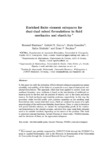Enriched finite element subspaces for dual–dual mixed formulations in fluid mechanics and elasticity

Use this link to cite
http://hdl.handle.net/2183/15576
Except where otherwise noted, this item's license is described as Reconocimiento-NoComercial-SinObraDerivada 4.0 Internacional
Collections
- Investigación (FIC) [1728]
Metadata
Show full item recordTitle
Enriched finite element subspaces for dual–dual mixed formulations in fluid mechanics and elasticityAuthor(s)
Date
2005Citation
R. Bustinza, G. N. Gatica, M. González, S. Medahi, et al. Enriched finite element subspaces for dual-dual mixed formulations in fluid mechanics and elasticity. Computer Methods in Applied Mechanics and Engineering, 2005, 194(2-5), 427-439.
Abstract
[Abstract] In this paper we unify the derivation of finite element subspaces guaranteeing unique solvability and stability of the Galerkin schemes for a new class of dual-mixed variational formulations. The approach, which has been applied to several linear and nonlinear boundary value problems, is based on the introduction of additional unknowns given by the flux and the gradient of velocity, and by the stress and strain tensors and rotations, for fluid mechanics and elasticity problems, respectively. In this way, the procedure yields twofold saddle point operator equations as the resulting weak formulations (also named dual–dual ones), which are analyzed by means of a slight generalization of the well known Babuška–Brezzi theory. Then, in order to introduce well posed Galerkin schemes, we extend the arguments used in the continuous case to the discrete one, and show that some usual finite elements need to be suitably enriched, depending on the nature of the problem. This leads to piecewise constant functions, Raviart–Thomas of lowest order, PEERS elements, and the deviators of them, as the appropriate subspaces.
Keywords
Twofold saddle point
PEERS
Enriched subspaces
Raviart–Thomas
PEERS
Enriched subspaces
Raviart–Thomas
Editor version
Rights
Reconocimiento-NoComercial-SinObraDerivada 4.0 Internacional
ISSN
0045-7825






